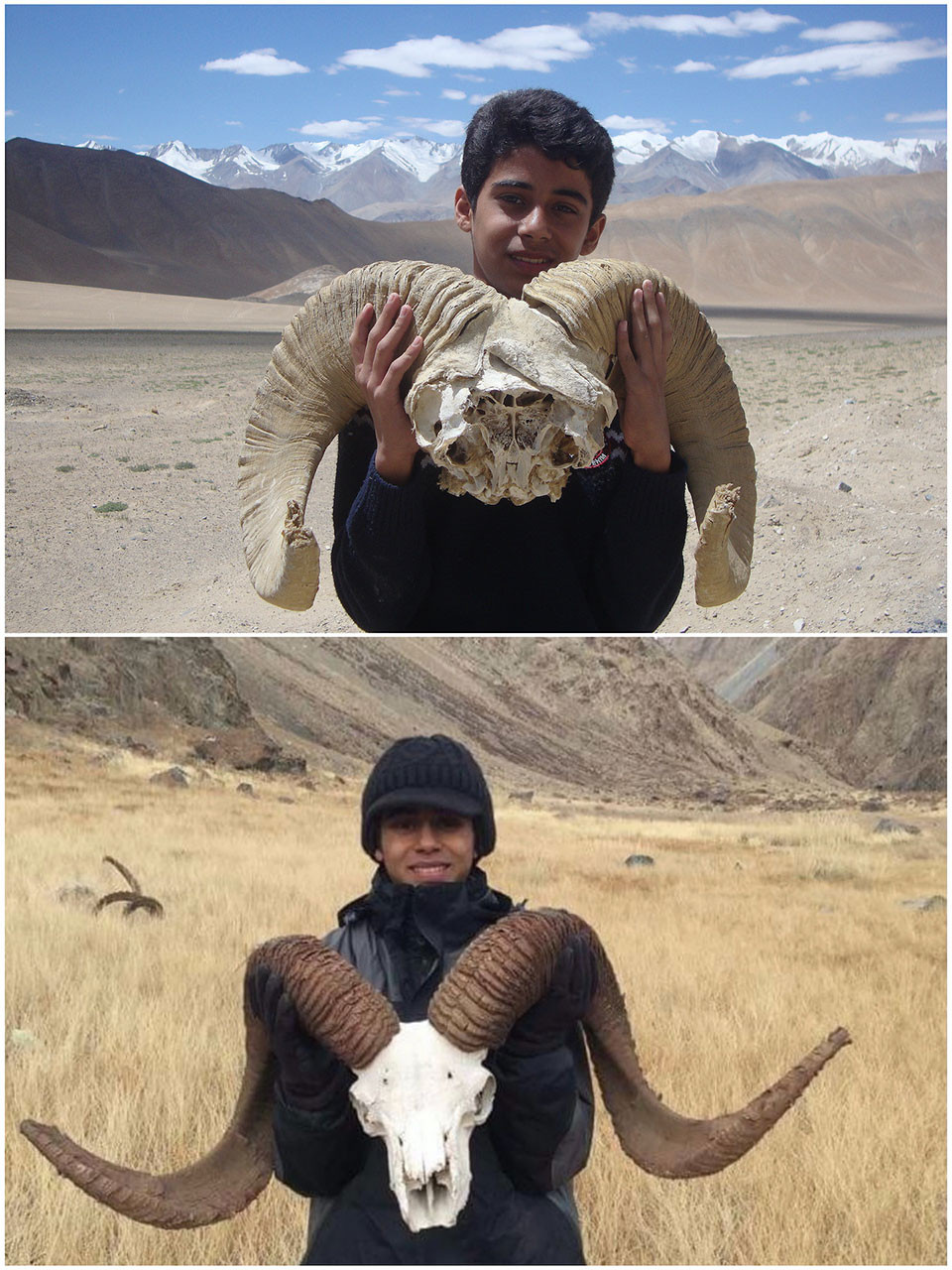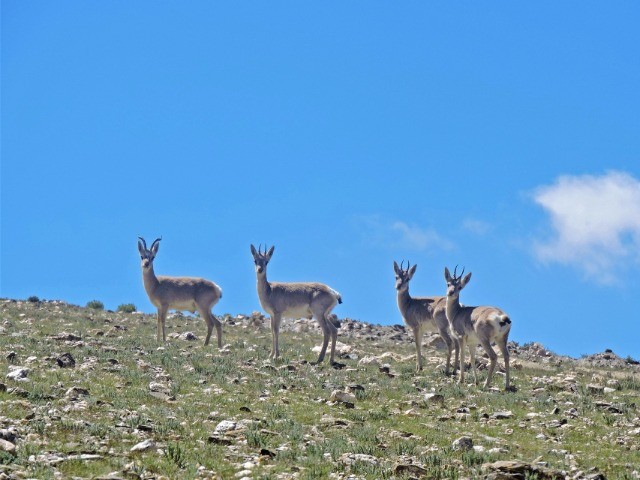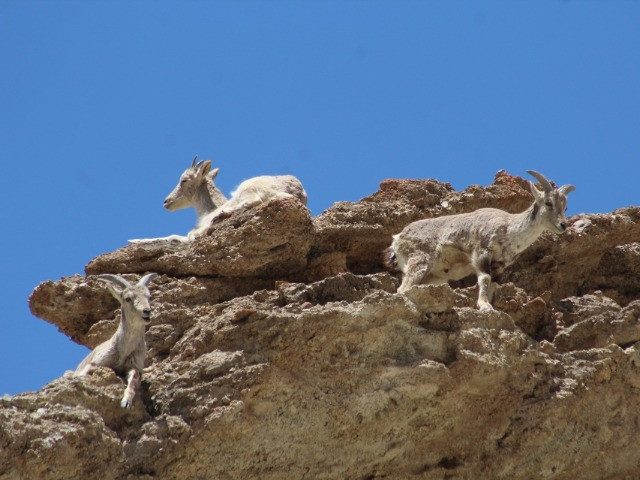It was a cold, frosty morning at the Sarychat-Ertash State Nature Reserve in Kyrgyzstan. I had stepped out to answer nature’s call, unaware of the most beautiful scene that was about to unfold before me. As the sun’s rays lit up the snow-clad peaks, there, on a ridge directly above where I was, appeared the most magnificent Tien Shan Argali. Standing proudly erect with its head held high and its rich breeding pelage with swollen white neck ruff glowing in the golden light of the dawn. I sat mesmerised for a while. This was exactly the scene I had cherished to capture for so long, my dream shot. A trophy hunter would have raised his Weatherby or Remington on him to shoot below his withers, instead, I ran back to the camp to fetch my Canon. By the time I returned, the Argali (Mongolian word for ram) had disappeared. I rushed after him, but on cresting the ridge he had melted away into the undulating grassy plains and was nowhere to be seen.
The Argali (Ovis ammon), like the Egyptian deity Ammon, from which it derives its name, sports majestic, curling horns, the longest of any wild sheep, and attains near-mythical status as one of the most coveted trophies by hunters. Their regal appearance and graceful bearing, the extreme wariness born of heavy hunting and natural predation, and their distribution in some of the most remote, elevated, desolate and conflict-ridden, often war-torn regions of the world only add to their mystique and allure. Theodore Roosevelt, who led a hunting cum specimen-collecting expedition for the Chicago Natural History Museum into Turkestan, called it the ‘mother and father of all wild sheep’. An expression later made famous by Saddam Hussain when he referred to the Gulf War as ‘the mother of all battles’.
The largest of all wild sheep, Argalis are found in the Central Asian highlands, spread across eleven countries. Across this extensive region, minor variations in their size, colour and horns occur. While IUCN and some international bodies recognise nine subspecies, Argali taxonomy remains disputed among scientists, with trophy hunting classifications further adding to the confusion. In his book Tibet Wild, George B Schaller writes about the ‘Tibetan Wild Sheep Scandal’ in which influential and wealthy individuals and reputed institutions were involved in the hunting and import of Tibetan Argali (Ovis ammon hodgsoni) trophies, banned under the US Endangered Species Act. To circumvent this law, additional subspecies were recognised as being found within their natural range in Tibet. Organisations such as ‘Grand Slam Club – Ovis’ and some professional hunters recognise hybrids such as Hume Argali and Matisoni Argali in regions where the territories of Marco Polo, Tibetan and Tien Shan Argalis overlap. Within the Indian subcontinent, two subspecies are found—Marco Polo Argali in northern Hunza and Tibetan Argali in eastern Ladakh and north Sikkim and occasionally in Spiti and the Trans-Himalayan fringes of Kumaon and Nepal.
My First Sighting
I had long been fascinated with Argalis, but I first went looking for them 10 years back, in 2011, when I visited the Tso Lhamu-Gurudongmar region, an extension of the Tibetan plateau in north Sikkim. Named after Guru Padmasambhava, the patron saint of Sikkim, who introduced Buddhism in Tibet, it is richly endowed with fauna representative of the Tibetan region, including a small population of Argali. Alas, due to bad weather and restricted access, I was unable to go to the area beyond Gyamchona lake, bordering Tibet, where most of the Argali sightings occur. But I did manage to see and photograph the Tibetan Sand Fox and Tibetan Sandgrouse—both first-timers for me. Some of the herders and locals I met spoke of instances of semi-feral dogs chasing and killing Argali and also of army personnel being tragically mauled to death.
I was luckier the following year when I had my first sighting of Argalis in Chang Chenmo valley in eastern Ladakh, formerly an important hunting ground and presently the scene of the Sino-Indian border standoff. Chang Chenmo range is an extension of the Karakoram range across the Shyok river, giving way to gentler topography consisting of rolling hills before merging with the Tibetan plateau. It is the only place in India where Wild Yak and Tibetan Antelope (Chiru) can still be found, along with Argali and other ungulates. The trip started with short forays into Hemis and Gya Miru, two villages located close to each other, followed by some exploration beyond Phobrang, where, at a road construction site beyond Shilung La (local word for mountain pass), we came across a skull of an Argali with bits of flesh and skin attached and some snares on the slopes near Thratsang La. We next crossed the Marsimik La to enter the Chang Chenmo valley. The progress was slow because the streams were swollen and muddy with snowmelt and we had to turn back from the raging Rimdi stream which drains into the Chang Chenmo river shortly before the Hot Springs. It was near Bahu Nala that we saw three Argalis standing across the stream, which simply took my breath away. It was a fleeting glimpse, but the scene is etched in my memory and was the beginning of a long quest that endures to this day.
Argalis are known to cross over from Ladakh into adjoining Spiti in Himachal Pradesh. I reached Spiti in 2015 to investigate this but had to return the very next day due to mountain sickness brought about by overexertion after trying to photograph an ‘uncooperative’ group of Himalayan Snowcocks without having acclimated myself.
In Central Asia
Given the difficulty of getting permission to see the legendary Marco Polo Argali in the nearby Pakistan-Occupied Kashmir (PoK), I was overjoyed when I got an opportunity to visit Kyrgyzstan, courtesy of the Snow Leopard Trust. Participating in an expedition to Sarychat-Ertash State Nature Reserve for collecting camera traps set up to monitor the Snow Leopard population, I got to see hundreds of Tien Shan Argalis, but they were extremely wary and difficult to approach or photograph. With the reserve itself surrounded by eight hunting concessions, I was told of instances of animals straying, or even being driven across, to be shot by trophy hunters, and of arrests being made by rangers for illegal hunting inside the reserve. We found a sack stuffed with a butchered Argali abandoned by poachers just outside the reserve. The rutting season had just commenced with the rams beginning to joust for supremacy, but it was time for us to depart. With winter in full swing, there was heavy snowfall, blocking all passes leading to At Bashy, and Murghab in Tajik Pamirs, both leading destinations for Marco Polo Argali trophy hunting, I had planned to visit. While most of these concessions are privately owned and essentially commercial operations some, including community-based hunting initiatives are said to practice sustainable hunting and support conservation.
The Indian Changthang
After finishing my 12th board exams in 2018, I volunteered with the Nature Conservation Foundation, participating in their ungulate surveys and conservation work in Ladakh. Covering a vast landscape in the districts of Leh and Kargil, we came across Argalis and other wildlife, but the very nature of the work precluded finding time for dedicated photography or carrying heavy equipment. On other occasions, we took time off to make quick assessment visits from Chushul to Demchok along the LAC (Line of Actual Control) and in areas beyond Hanle such as Kalakh Tar, Tar and hills near Chumur, the plains bordering the Tso Moriri and Tso Kar lakes. Compared to central Asia where it is not uncommon to see hundreds of Tien Shan or Marco Polo Argalis in a day, often in large herds, the Tibetan Argalis I encountered in Ladakh were far fewer in number and in herds not exceeding a score in number. In his book Tibet Wild, Schaller has commented upon the Tibetan Argalis being rare across the vast expanse of the plateau and being found in small herds.
My plans to visit Ladakh with my colleagues Rigzen Dorjay and Sherab Lobzang last autumn to catch the rutting of Argalis went awry because of covid restrictions and by the time I could visit, it was peak winter. Even so, there was heavy disturbance due to the massive deployment of troops. With Chushul chock-a-block with heavy armour (possibly the highest active massed deployment ever at 15000ft), and other promising areas being similarly closed, we went to Yaya Tso. It was the middle of chillai-kalan, the harshest period of winter, and we were hoping to find the Argalis at a lower altitude given their aversion for deep snow but were disappointed to find them still occupying the high pastures because of uncommonly scanty snowfall. Moving at last to Tsaba valley in Gya Miru, our old tramping ground, we found the situation no different, and so decided to camp with our herder friends who, as on many occasions during our earlier surveys, generously offered us shelter.
I quite like the desert and have come to admire its austere, frugal ways. Here, in the arid high steppes, where life exists on the edge, people have coexisted with wildlife for ages, practising pastoralism in a limited, sustainable way. Rising demand for Pashmina wool and the increasing encroachment of livestock into rangelands can upset this balance to the disadvantage of wild herbivores like Argalis. There was a study conducted here in Tsaba valley (Tsewang Namgail, Yashveer Bhatnagar et.al 2006), which documented Argalis being pushed to suboptimal habitats by domestic livestock. As the economy of Ladakh opens up, offering new avenues of employment and income generation, in place of pastoralism, and its people, particularly its youth, leave for ‘greener pastures’, one hopes, it will leave the ‘pastures greener’ for its wildlife.
After waiting in vain for the Argalis to descend, we decided to stalk up to a small group with two adult rams we had located high up on a ridge with our binoculars. Like suicide bombers, we went to sleep with the camera batteries strapped around our chests, using the body warmth to prevent them from getting discharged in the intense cold. Stepping out of our sleeping bags, crisp with frost, we started early, aiming to make it to the top of a high feature (at nearly 18000ft), overlooking a saddle, where the group had been seen grazing. Weighed down by our heavy photography gear, the progress was slow, and it was evening when we reached there. Keeping the sun behind us, and with the wind in our favour, we descended cautiously, but the wily Argalis, somehow sensing our presence, came out running, slowing down a bit only after putting a safe distance between us, and without so much as a glance to see what disturbed them, disappeared from view, dashing all hopes of photographing them. And so the quest, keener with each failure, continues.












